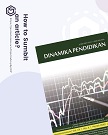An Analysis of Student Engagement for Online Microeconomics Class Based on ELED
(1) Universitas Negeri Semarang
(2) Universitas Negeri Semarang
Abstract
This study aims to analyze the factors affecting student engagement in Microeconomics online classes based on E-Learning Engagement Design (ELED). This study applied a mixed method with a sequential model. The study population included all students of the Department of Economics Education UNNES who took online courses in Microeconomics and Microeconomics 1, both regular and international classes, with a total of 320 students and 4 lecturers handled the classes. The results showed that situational interest, personal significance, mastery of self-talk and mastery of self-talk for performance had a positive effect on student engagement in Microeconomics online classes. Meanwhile, mastery of self-talk to avoid negativity, environmental control, independent consequences, and setting proximal goals do not significantly influence student engagement in Microeconomics online classes. The concept of E-Learning Engagement Design (ELED) has been applied to all components. However, it is necessary to standardize the learning environment components to make sure there is no gap among Microeconomics classes which leads to less optimal academic services.
Keywords
Full Text:
PDFReferences
Anazifa, R. D., & Djukri, D. (2017). Project-Based Learning and Problem-Based Learning: Are They Effective to Improve Student’s Thinking Skills? Jurnal Pendidikan IPA Indonesia, 6(2), 346-355. DOI: 10.15294/jpii.v6i2.11100
Creswell, J. W., Plano Clark, V. L., Gutmann, M. L., & Hanson, W. E. (2003). An expanded typology for classifying mixed methods research into designs. A. Tashakkori y C. Teddlie, Handbook of Mixed Methods in Social and Behavioral Research, 209-240.
Crowe, S., Cresswell, K., Robertson, A., Huby, G., Avery, A., & Sheikh, A. (2011). The case study approach. BMC Medical Research Methodology, 11(1), 1-9. DOI: https://doi.org/10.1186/1471-2288-11-100
Czerkawski, B. C., & Lyman, E. W. (2016). An instructional design framework for fostering student engagement in online learning environments. TechTrends, 60(6), 532-539. DOI: 10.1007/s11528-016-0110-z
Genc, M. (2015). The project-based learning approach in environmental education. International Research in Geographical and Environmental Education, 24(2), 105-117. DOI: 10.1080/10382046.2014.993169
Hidi, S., & Renninger, K. A. (2006). The four-phase model of interest development. Educational psychologist, 41(2), 111-127. DOI https://doi.org/10.1207/s15326985ep4102_4
Hung, C. M., Hwang, G. J., & Huang, I. (2012). A project-based digital storytelling approach for improving students’ learning motivation, problem-solving competence and learning achievement. Journal of Educational Technology & Society, 15(4), 368-379. Retrieved from https://www.jstor.org/stable/pdf/jeductechsoci.15.4.368.pdf
Huang, C. (2011). Achievement goals and achievement emotions: A meta-analysis. Educational psychology review, 23(3), 359. DOI 10.1007/s10648-011-9155-x
Keller. (2008). An integrative theory of motivation, volition, and performance. Technology, Instruction, Cognition & Learning, 6(2), 79–104.
Khan, Arshia, Ona Egbue, Brooke Palkie, & Janna Madden. (2017). Active Learning: Engaging Students to Maximize Learning in an Online Course. The Electronic Jounal of e-Learning. Vol. 15, page 1. Retrieved from https://academic-publishing.org/index.php/ejel/article/view/1824
Lee, Jeongju, Hae-Deok Song, & Ah Jeong Hong. (2019). Exploring Factors, and Indicators for Measuring Student’s Sustainable Engagement in e-Learning. Journal of Sustainability. Vol. 11, No. 985, 3 – 9. DOI: https://doi.org/10.3390/su11040985
Peng, Wang. 2016. Research on Model of Student Engagement in Online Learning. EURASIA Journal of Mathemathics Science and Technology Education. Vol. 13, No. 7. Page 2871-2872. DOI: https://doi.org/10.12973/eurasia.2017.00723a
Popil, I. (2011). Promotion of critical thinking by using case studies as teaching method. Nurse Education Today, 31(2), 204-207. DOI: https://doi.org/10.1016/j.nedt.2010.06.002
Rahman, N. A. A., Hussein, N., & Aluwi, A. H. (2015). Satisfaction on Blended Learning in a Public Higher Education Institution: What Factors Matter?. Procedia-Social and Behavioral Sciences, 211, 768-775. DOI: https://doi.org/10.1016/j.sbspro.2015.11.107
Renninger, K. A., & Bachrach, J. E. (2015). Studying triggers for interest and engagement using observational methods. Educational Psychologist, 50(1), 58–69. DOI: 10.1080/00461520.2014.999920
Schwinger, M., Steinmayr, R., & Spinath, B. (2012). Not all roads lead to Rome: Comparing different types of motivational regulation profiles. Learning and Individual Differences, 22, 269–279. DOI: 10.1016/j.lindif.2011.12.006
Smit, K., De Brabander, C. J., Boekaerts, M., & Martens, R. L. (2017). The self-regulation of motivation: Motivational strategies as mediator between motivational beliefs and engagement for learning. International Journal of Educational Research, 82, 124–134. DOI: 10.1016/j.ijer.2017.01.006
Wang, M. T., & Eccles, J. S. (2012). Adolescent behavioral, emotional, and cognitive engagement trajectories in school and their differential relations to educational success. Journal of Research on Adolescence, 22(1), 31-39. DOI: https://doi.org/10.1111/j.1532-7795.2011.00753.x
Wolters, C. A. (2003). Regulation of motivation: Evaluating an under emphasized aspect of selfregulated learning. Educational Psychologist, 38, 189–205. doi:10.1207/S15326985EP3804_1
Zhang, W., Wang, Y., Yang, L., & Wang, C. (2020). Suspending Classes Without Stopping Learning: China’s Education Emergency Management Policy in the COVID-19 Outbreak. Journal of Risk and Financial Management, 13(55), 1-6. https://doi.org/10.3390/jrfm13030055
Refbacks
- There are currently no refbacks.

This work is licensed under a Creative Commons Attribution 4.0 International License.


.png)

.png)





